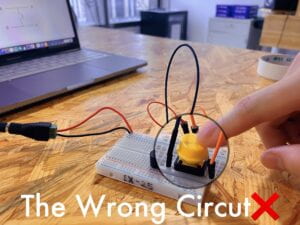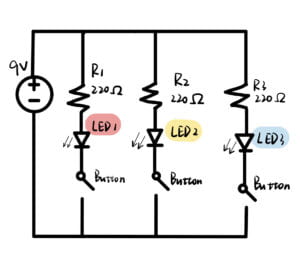During the first week of recitation, I paired with Loki to connect and make a circuit.
As a liberal arts student, I learned for the first time that many circuit components play a vital role in the proper functioning of circuits.
The first are resistors. Resistors are mainly used to regulate and stabilize current and voltage in circuits. Since the battery provides more current and voltage than the LED light can carry, to prevent a short circuit, a resistor should be used when connecting the light.

The second is the LED. Whether the LED light is on or not reflects whether a circuit is running normally, which can help us better grasp the internal situation of the circuit and quickly respond to the circuit connection.
A variable resistor is a resistor whose resistance value can be adjusted. It is used when the circuit current needs to be adjusted, or the circuit resistance needs to be changed. In our circuit, it acts the same as a resistor.
The switch is one of the core components of our circuit. It controls the work of the buzzer and LED lights through the connection and blocking of current, and promotes the interaction between the circuit and people.
The buzzer will beep when the current is connected to the circuit. Its presence facilitates an auditory shift in the circuit. The power supply is critical to the operation of a circuit, providing energy for all components to function properly.
GND is used as the 0V reference point for different functional circuits, which helps to reduce mutual interference between circuits and form other current circuits. Finally, there is the circuit board, which is a unique design and structure that provides the medium for the connection and communication of all the above circuit elements, and the platform for forming the circuit.
In the first step of connecting the buzzer to the circuit, we found that the buzzer was not working. So we consulted the learning assistant and found that when the switch was wired, there was no diagonal line but the same direction connection, resulting in a short circuit at the switch, so the buzzer did not work. We went through the switch block diagram in the reference, changed the wiring at the switch, and finally completed step 1.

In the second task, we carefully inserted the resistors and diodes with one of their two cables inserted parallel to each other and the other next to the connecting cable. The whole process went smoothly.
If they are connected in parallel, there will be a situation where the LED cannot be controlled, and the LED will stay on instead of following the switch.
Then we successfully finished the last task.
We also replaced the original switch with the self-made switch. Question 1:
R1 is mainly used to regulate and stabilize the current and voltage in the circuit. Since the battery provides more current and voltage than the LED1 can carry, to prevent a short circuit, a resistor (R1) should be used when connecting LED1.
Question 2:

Question 3:
I think the interactivity of the circuits we make today is that we can turn on an LED and sound a buzzer by pressing a button and closing the circuit. I find this circuit to be very interactive. When I press the button, it’s like listening to the interaction. The circuit starts thinking from my instructions, and finally speaks the information in the form of a buzzer and LED, forming a benign interaction between information and between people and circuits.
Question 4:
Interaction design and physical computing create media and platforms where humans resonate with the digital world, providing tools for the transformation of information about human behavior and the creation of interactive art. Just like a human-computer interaction technology called Eyewriter launched by Zack Lieberman, it can capture the focus of the line of sight and use the eyes as a brush to write and draw, not only to help paralyzed patients better express their personal needs but also to promote interaction The creation and development of art. The application of interaction design and physical computing expands practical human tools, enabling humans to create more colorful art.




